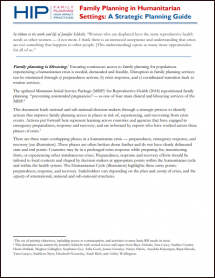Family Planning in Humanitarian Settings: A Strategic Planning Guide
This document leads national and sub-national decision-makers through a strategic process to identify actions that improve family planning access in places at risk of, experiencing, and recovering from crisis events. Actions put forward here represent learning across countries and agencies that have engaged in emergency preparedness, response and recovery, and are informed by experts who have worked across these phases of crisis.
There are three main overlapping phases in a humanitarian crisis — preparedness, emergency response, and recovery. These phases are often broken down further and do not have clearly delineated start and end points. Countries may be in a prolonged crisis response while preparing for, transitioning from, or experiencing other simultaneous crises. Preparedness, response and recovery efforts should be tailored to local contexts and shaped by decision makers at appropriate points within the humanitarian cycle and within the health system. The Humanitarian Cycle (illustration) highlights these entry points: preparedness, response, and recovery. Stakeholders vary depending on the phase and severity of crisis, and the capacity of international, national and sub-national structures.
Last modified: July 21, 2020
Language: English

